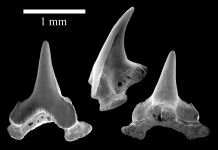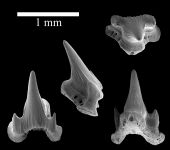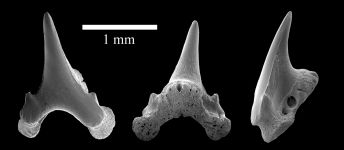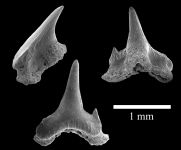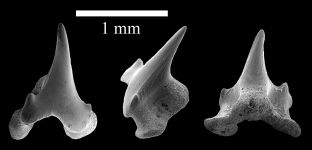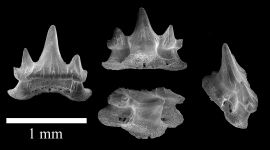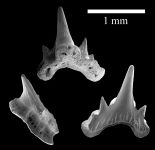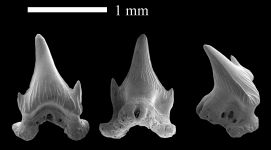Scyliorhinus biformis
Reinecke, 2014
Classification: Elasmobranchii Carcharhiniformes Scyliorhinidae
Reference of the original description
Two new scyliorhinid shark species (Elasmobranchii, Carcharhiniformes, Scyliorhinidae), from the Sülstorf Beds (Chattian, Late Oligocene) of the southeastern North Sea Basin, northern Germany. Palaeovertebrata, 38(1), 1–8
Two new scyliorhinid shark species (Elasmobranchii, Carcharhiniformes, Scyliorhinidae), from the Sülstorf Beds (Chattian, Late Oligocene) of the southeastern North Sea Basin, northern Germany. Palaeovertebrata, 38(1), 1–8
Synonyms / new combinations and misspellings
Scyliorhinus cf. biformis
Scyliorhinus cf. biformis
Types
Scyliorhinus biformis
Holotype: SMF(fossil): P 9804; Paratype: SMF(fossil): P 9805; SMF(fossil): P 9806;
Scyliorhinus biformis
Holotype: SMF(fossil): P 9804; Paratype: SMF(fossil): P 9805; SMF(fossil): P 9806;
Description:
Citation: Scyliorhinus biformis Reinecke, 2014: In: Database of fossil elasmobranch teeth www.shark-references.com, World Wide Web electronic publication, Version 01/2026
Please send your images of "Scyliorhinus biformis" to info@shark-references.com
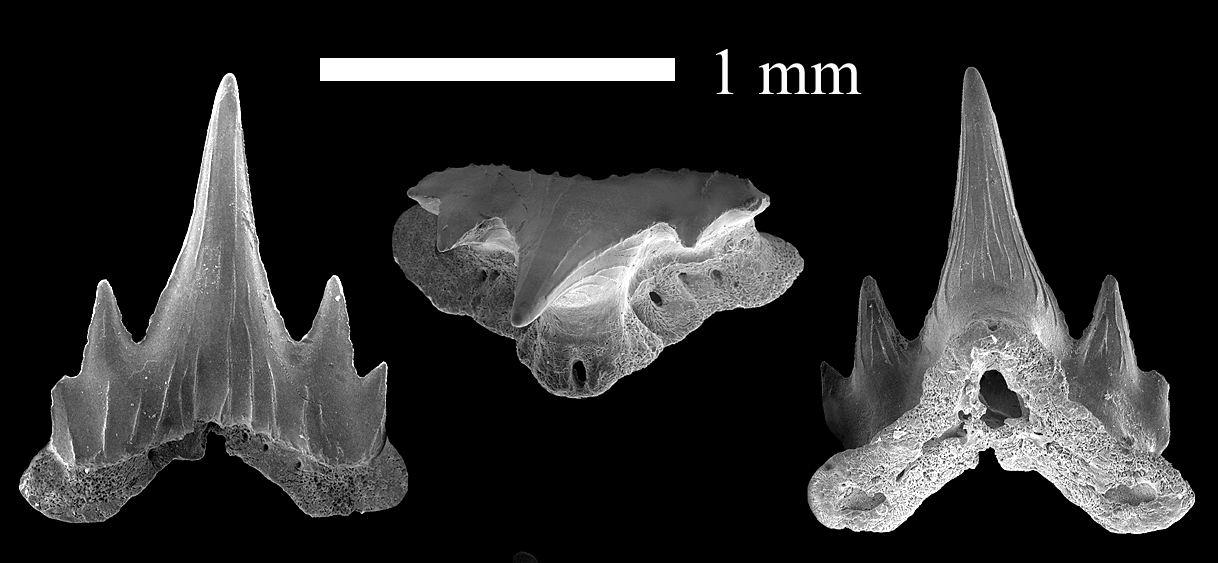
Scyliorhinus biformis Reinecke, 2014; holotype, Sülstorf Formation, early-middle Chattian, late Oligocene; Kobrow, Germany, coll. Senckenberg Research Institute and Natural History Museum, Frankfurt SMF P 9804 © T. Reinecke, Bochum.

Scyliorhinus biformis Reinecke, 2014; holotype, Sülstorf Formation, early-middle Chattian, late Oligocene; Kobrow, Germany, coll. Senckenberg Research Institute and Natural History Museum, Frankfurt SMF P 9804 © T. Reinecke, Bochum.
Description
Description (Reinecke, 2014) [20689]: Teeth of the female morph have an upright to noticeably inclined principal cusp which is slender and not high. The cusp has a conical shape. Its mesial and distal cutting edges extend from the apex to the basal notch and continue to the lateral margins of the cusplets. There exists one pair of sharp cusplets in anterior teeth having a narrow crown basis, and - more rarely - a second (outer), much lower pair occurring in basally broader teeth that probably derive from more lateral jaw positions. In some specimens the outer cusplet occurs on the mesial heel only. While both crown faces are transversally convex, the lingual face is much more convex than the labial one. The apico-basally convex labial crown basis markedly overhangs the root. The lower third to half of the labial crown face is covered with sharp longitudinal ridges which are partly anastomosing. On the lingual crown face (including the cusplets) the ridges are more flexuous, less sharp and reach higher up to the apex than on the labial face. The root is not high, basally broader than the crown, and shows a salient lingual protuberance. The lobes are well separated and elongate in lateral files and have semicircular, well-rounded terminations. The basal face of the root is rather flat and lacks a nutrient groove. Two larger foramina open on the lingual side of the protuberance and in the labial axial region of the basal face. The lingual root faces on either sides of the protuberance are deepened and bear 3-4 larger foramina. Some smaller foramina are scattered on the root faces. Teeth of the male morph have very similar characters in cusp and root morphology as teeth of the female morph, but differ from these by the presence of much weaker ridges (being absent in some specimens) on the lowermost part of the labial crown face. The ornamentation of the lingual crown face is comparable to that of the female morph. The height of the cusplets in the male morph is quite variable. Some teeth lack cusplets on the mesial or distal heel, others have low, blunt cusplets on either sides or display sharp cusplets which are as high as those observed in the female morph. These differences are apparently not related to gradient monognathic heterodonty.
Description (Reinecke, 2014) [20689]: Teeth of the female morph have an upright to noticeably inclined principal cusp which is slender and not high. The cusp has a conical shape. Its mesial and distal cutting edges extend from the apex to the basal notch and continue to the lateral margins of the cusplets. There exists one pair of sharp cusplets in anterior teeth having a narrow crown basis, and - more rarely - a second (outer), much lower pair occurring in basally broader teeth that probably derive from more lateral jaw positions. In some specimens the outer cusplet occurs on the mesial heel only. While both crown faces are transversally convex, the lingual face is much more convex than the labial one. The apico-basally convex labial crown basis markedly overhangs the root. The lower third to half of the labial crown face is covered with sharp longitudinal ridges which are partly anastomosing. On the lingual crown face (including the cusplets) the ridges are more flexuous, less sharp and reach higher up to the apex than on the labial face. The root is not high, basally broader than the crown, and shows a salient lingual protuberance. The lobes are well separated and elongate in lateral files and have semicircular, well-rounded terminations. The basal face of the root is rather flat and lacks a nutrient groove. Two larger foramina open on the lingual side of the protuberance and in the labial axial region of the basal face. The lingual root faces on either sides of the protuberance are deepened and bear 3-4 larger foramina. Some smaller foramina are scattered on the root faces. Teeth of the male morph have very similar characters in cusp and root morphology as teeth of the female morph, but differ from these by the presence of much weaker ridges (being absent in some specimens) on the lowermost part of the labial crown face. The ornamentation of the lingual crown face is comparable to that of the female morph. The height of the cusplets in the male morph is quite variable. Some teeth lack cusplets on the mesial or distal heel, others have low, blunt cusplets on either sides or display sharp cusplets which are as high as those observed in the female morph. These differences are apparently not related to gradient monognathic heterodonty.
Remarks
shark-references Species-ID=14030;
shark-references Species-ID=14030;
References
Combining palaeontological and neontological data shows a delayed diversification burst of carcharhiniform sharks likely mediated by environmental change. Scientific Reports, 12, Article 21906
DOI: 10.1038/s41598-022-26010-7
Haie im Alpenvorland - Fossile Zeugen eines verschwundenen Paradieses. Verlag Anton Pustet, Salzburg, ISBN-10: 3702510230
Feeding ecology has shaped the evolution of modern sharks. Current Biology, 31(23), 5138–5148
DOI: 10.1016/j.cub.2021.09.028
A new deep-sea elasmobranch fauna form the Central Paratethys (Neuhofener Beds, Mitterdorf, near Passau, Germany, Early Miocene, Middle Burdigalian). Zitteliana, 90, 27–53
DOI: 10.5282/ubm/epub.40476
Combining palaeontological and neontological data shows a delayed diversification burst of carcharhiniform sharks likely mediated by environmental change. Scientific Reports, 12, Article 21906
DOI: 10.1038/s41598-022-26010-7
Haie im Alpenvorland - Fossile Zeugen eines verschwundenen Paradieses. Verlag Anton Pustet, Salzburg, ISBN-10: 3702510230
Feeding ecology has shaped the evolution of modern sharks. Current Biology, 31(23), 5138–5148
DOI: 10.1016/j.cub.2021.09.028
A new deep-sea elasmobranch fauna form the Central Paratethys (Neuhofener Beds, Mitterdorf, near Passau, Germany, Early Miocene, Middle Burdigalian). Zitteliana, 90, 27–53
DOI: 10.5282/ubm/epub.40476









